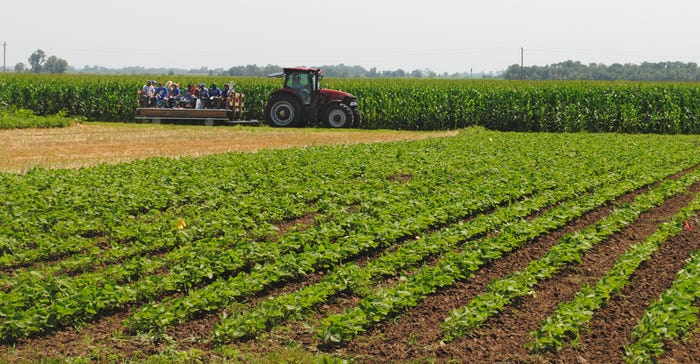
TOURING THE FIELDS: Scores of research trials were covered at the summer field day at the South Dakota State University Southeast Research Farm near Beresford, S.D. in early July. Wagon tours of three different groupings of research trials covered numerous agronomic and conservation topics.
Each year, Extension Research Farms across the country conduct numerous studies and trials to help farmers become more profitable and sustainable. When we attended the recent Southeast South Dakota Research Farm summer field day near Beresford, S.D., conducted by South Dakota State University Extension, we learned about three studies that may have implications for farmers across certain regions in the Dakotas. Here are the studies to watch:
• Testing rye cover crops for reducing nitrates in tile drainage. Rye is a popular cover crop on its own and within seed mixtures. Peter Sexton, SDSU Southeast Farm Supervisor, told field day participants about a study looking at how rye cover crops may positively impact the quality of tile drainage water, which reduced water nitrate levels.
"The hope is that rye as a cover crop will improve soil health and have a cumulative effect over four or five years so we start to see a yield bump," Sexton said. "We also wanted to look at how rye might help clean up water in tile lines like a living filter. After soybean harvest, we planted rye in the fall to get it established so it has a living root system."
The idea is that rye will absorb whatever nitrogen it can and keep from going into the drain tile. Researchers terminated the rye cover crop and planted corn in the field this year. Corn was also planted in adjacent check plots without a rye cover. Weekly water quality readings are taken from the drain tile from each of the fields to identify differences in nitrogen and phosphorus. Excessive rain near Beresford may have altered the readings this year, but Sexton said they will have enough readings over the course of this three-year study to learn more.
"Our next plan this summer is to install nitrogen sensors on data loggers, so we get continuous data of nitrates in the water line," he said. "We are the first researchers in the country to do this. Next year, we can look at the continuous data and compare it to rainfall. We will have information on how rye impacts nitrates in the water, as well as the impact of rainfall events."
The project is being supported by the James River Water Development Board, Eastern South Dakota WDB, SDSU Southeast Research Farm Board and NRCS.
• Forage trials test yield and cattle preference. Trials on annual forages are looking at individual species and forage mixtures, not only for yield but also for preference by grazing cattle.
Sara Bauder, SDSU Extension agronomy field specialist, explained that the study includes six replicated trials for winter annual forages planted in April. Part of the plots are clipped with a forage harvester, and the other plots are being grazed by cattle. While some plots include a mixture of forage species, even individual species plots include oats as a nurse crop to get them going, Bauder said.
"In the grazed plots, we measure how much was grazed, and how yield compared with plots cut by a forage harvester," she explained. "Forage yield was calculated in dry matter tons per acre."
Researchers divided the crops into high yielding and low yielding groups, and then graded each mixture for cattle preference, along with adding a visual rating. "It’s important to note that the visual rating doesn’t always match up to yield data due to trampling of the plots during grazing," Bauder said. "We allowed cattle in the grazed plots to back graze to the water tank. We grazed the plots to about 50% of the forage and then moved them." So far, brassica crops yield lower than grass crops. "This highlights the advantages of having a mix."
"Oat mixtures were high yielding and preferred by the cattle," Bauder added. "We will measure this again, along with the regrowth due to grazing. We’re trying to get an idea of the best yielding mixtures and what the cattle impact is."
• In-season nitrogen application timing trials to improve efficiency. High rainfall in the spring, coupled with corn’s low nitrogen uptake, can lead to a loss of nitrogen fertilizer that is applied pre-planting. This loss of nitrogen can lead to reduction in yield, according to Jason Clark, SDSU Extension soil fertility specialist.
"If we can move nitrogen applications away from early in the spring to in-season, we could provide opportunity for better yields," Clark said.
This is the first year for this SDSU study at three research locations in eastern South Dakota. The study compares single pre-plant and split nitrogen fertilizer applications for impact on corn yield. Moving the majority of nitrogen fertilizer applications closer to the time when corn is rapidly taking up nitrogen, like around V6 growth stage, is also moving the application timing away from the normal periods of highest rainfall.
"In years of heavy rainfall, maybe we can wait with some applications," Clark noted.
The result of more in-season, split nitrogen application on corn may improve yields and lower the amount of nitrogen needed. "We want to look at when applications work and why they work," he said. "That’s the goal of this project. By next summer, we’ll have more data."
This project is funded by the South Dakota Nutrient Research and Education Council.
About the Author(s)
You May Also Like






